The Legend of Zelda: Wind Waker Review – Is it Worth Playing Now?
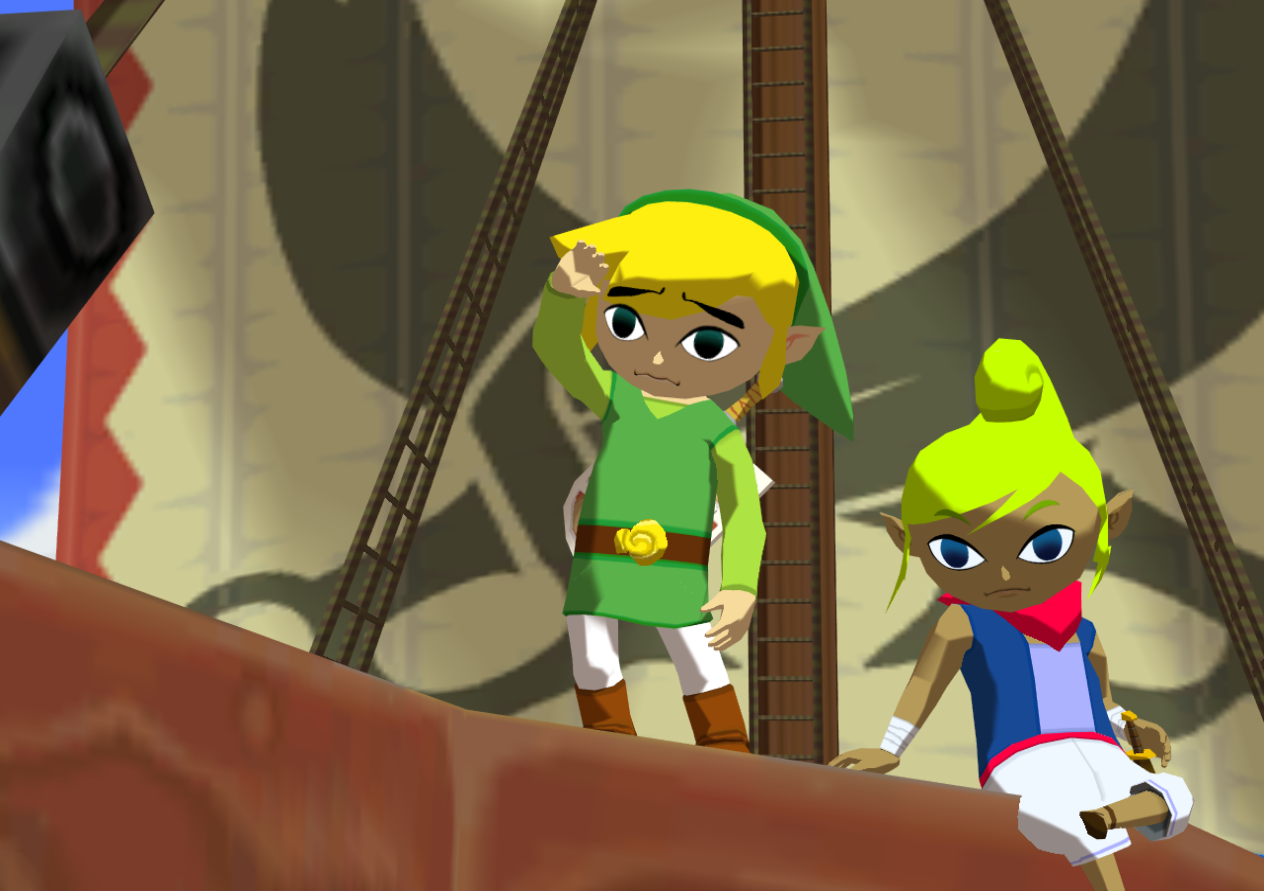
This is a review of the original Wind Waker on the GameCube. I thought I’d review it as it’s one of my all-time favourite games, though is certainly not without its flaws.
Brief synopsis
The Legend of Zelda: Wind Waker released in 2002 for the Nintendo GameCube. The game sported a change in graphical style from previous entries, with a cel-shaded cartoon aesthetic; and saw the player traverse the open waves in an adventure spanning a vast ocean, visiting islands, discovering treasure and battling pirates.
The Good
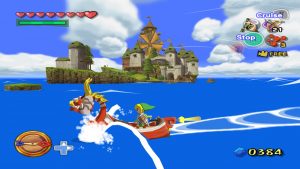
Seeing an island looming in the distance and sailing towards it is one of the game’s most satisfying pleasures.
+ Sense of adventure: The best thing about the game is the way it manages to evoke the sense of real adventure and exploration. The Great Sea seems to expand forever, and some of the greatest pleasures of the game come from spotting an island in the distance, deciding to sail towards it, and watching it gradually grow larger as you approach. There are no loading times between islands, which is crucial in helping the game achieve its sense of grandeur. Other Zeldas in the series, both subsequent and previous, don’t quite manage this as well as Wind Waker.
+ Graphics: Wind Waker’s graphics are beautiful, and simply haven’t aged. Comparing this game to other games released in 2002, the contrast can be quite remarkable. The cel shading allows for the characters to really appear and feel like they are an organic part of the world they occupy, something games today still struggle to achieve. There are lovely little touches that help add to the overall effect – heat haze in the lava-laden Dragon Roost Isle, the soft glow of the Master Sword, the shadows cast from the flames of torches as Link runs past them, and the swirls in the air indicating the direction of the wind all good examples of the polish Nintendo has applied.
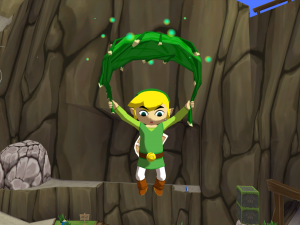
Link’s expressions are always changing and reaccting to the world around him.
+ Sound: Ocarina of Time and Majora’s Mask excelled in the audio department, and Wind Waker manages to stand alongside them with an excellent score. Each island has its own tune in-keeping with the tone and atmosphere of the location, and the majestic anthem that plays when you set sail is one of the best ‘overworld themes’ in the franchise. Where the sound truly excels is in the combat – every time you swing your sword, the music reacts accordingly, dramatic chords struck with each blow.
+ Charm: The game is brimming with charm. Before release Nintendo placed a big emphasis on Link’s facial expressions, and it really pays off when you play. Link’s eyes follow enemies, lock onto points of interest, and widen and narrow depending on Link’s emotions, and all this helps create one of the most likeable and charming iterations of Link. This great article from 3D artist Ben Jones goes into quite a lot of depth about how the eyes in Wind Waker and Twilight Princess achieve these expressions, and goes to show the investment Nintendo put into their character’s faces. The game’s charm extends beyond Link however, with enemies and NPCs all oozing character and possessing a whimsical individuality that most other games don’t come close to.
+ Fluid combat: The combat in Wind Waker is simple, yet fast, fluid and fun. It builds on the targeting system established in OoT by a adding a few moves and most significantly an excellent parry system – if the player presses ‘A’ at the right time when an enemy attacks, Link performs a satisfying counter-swipe. It’s a simple addition but adds a lot to the enjoyment of the combat.
+ Player respect: Despite not being particularly challenging, what Wind Waker does really well is strike the balance between leaving the player to their own devices, and providing assistance when needed. Your companion, the King of Red Lions, compares favourably to previous sidekicks Navi and Tatl as he never gets in the way, only interrupting the game two or three times in total. If you do need help however, he’s always there to give you a nudge in the right direction. This level of player respect has become lost in recent iterations of the franchise, and it’s something I hope Nintendo becomes conscious of and addresses in later installments.
Neither Good nor Bad
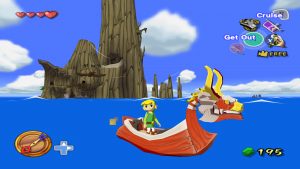
There is a lot of sailing, but it only really becomes tedious when you have to constantly change direction.
Sailing: One of the criticisms often made of the game is that sailing between islands becomes laborious. It does often take a few minutes to traverse between islands, however I personally don’t necessarily deem this as a fault. The ocean between the islands is filled with enemies, treasure,mini-fortresses and secret submarines, so the player is rarely idle, and having to spend time sailing between islands helps to maintain the feel of the scope and size of Hyrule. What does become tedious is changing the wind to change direction, but more on that below.
Difficulty: Some critics also feel that the game is too easy. I would argue that whilst it’s probably the least challenging of the Zeldas, the lower difficulty fits well with the whimsical aesthetic. The game’s enjoyment doesn’t come from surpassing its challenge, it comes from exploring its world and discovering new things.
The Bad
-The Wind Waker: The Wind Waker itself is a rather disappointing tool, particularly when compare dot the Ocarina o f Time. It feels very underutilized and not quite thought through properly, and this is summed up quite nicely when you actually receive it – literally as an after-thought from the King of Red Lions. Having to take down the sail and wait for an animation every time you want to change sailing direction gets particularly tedious, though I know this has been streamlined to a degree in the recent HD re-release.
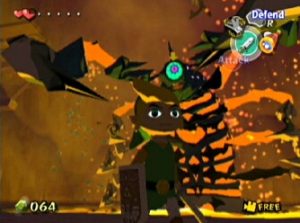
The bosses look spectacular but are disappointingly simple and easy to defeat.
-Boat combat: Another element that seems to have been included without enough thought from the designers is the boat combat. Using the cannon or your bow on the boat requires putting down the sail and thus coming to standstill making you a sitting duck for enemies. Sadly this means you’re better off just bypassing the ocean-based enemies rather than taking them on.
-Unfinished: The only major criticism of the game is the nagging sense that there should have been more. Two dungeons were cut from the game due to time constraints, and whilst the game tries to make up for this with the controversial (though I don’t really mind it) Triforce quest, it still leaves the gamer with a nagging feeling of what could have been.
-Dungeons and bosses: Although Wind Waker’s overworld excels at being everything it should, the dungeons are some of the weaker in the series, both in terms of length and presenting a compelling challenge. The boss fights in particular are sadly rather forgettable and often too easy – with the exception of the final showdown which is one of the best in the series.
Overall
Wind Waker is a game greater than the sum of its parts – it transcends its flaws and gives the player an unforgettable and hugely enjoyable adventure.
9/10
You can definitely see your expertise within the work you write.
The sector hopes for even more passionate writers like you who aren’t afraid to mention how they believe.
At all times go after your heart.
Here is my website – 우리카지노
If some one desires expert view about running a blog afterward i propose him/her to visit this website, Keep up the
pleasant work.